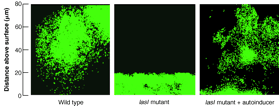Chapter 1 - End of Chapter Questions
1. Match the following characteristics with the terms Planktonic and Biofilm.
- ___cell growth is usually determined by nutrient concentration.
- ___often characterized by the presence of flagellae
- ___usually embedded in a "slimy" matrix
- ___unusually resistant to antibiotics
- ___often present a problem in water treatment Plants
-
A. Planktonic cells
by nutrient concentration.
B. Sessile cells (biofilms) of flagellae
C. Both of these matrix
2. Depending on the specific situation, biofilms may be considered beneficial, detrimental or neutral. The decision depends upon how they affect humans and their cultural systems. For each of the following describe one beneficial and one detrimental biofilm and explain why you chose as you did.
-
A. Human Health
Care
B. Agricultural
C. Industrial
D. Art and Architecture
- A. Art preservationists
B. Anthropologists
C. Petroleum engineers
D. Designers of artificial heart valves
E. Heating and air-conditioning engineers
F. Can you think of researchers in other “exotic” fields who might have a interest in biofilm research?
4. In the cartoon (page one, Chap 1 sec.3), a rather depressed bacterium confides in his microbial therapist that he is thinking of joining a biofilm. How will he be better off is he actually does so? Are there any ways in which he may be in a worse position?
Chapter 1 - Summary Questions
1a. Using this diagram of the light path of a confocal scanning laser microscope, explain why the CSLM gives better resolution of subjects like biofilms than does traditional light or brightfield microscopy.
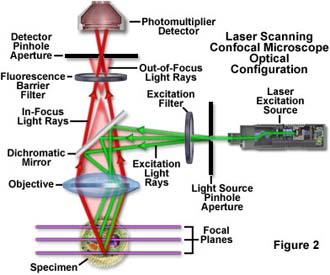
Chapter 1 - Scenerio Questions
1. If we are able to keep biofilms from forming on ship hulls and piers in aquatic environments by using compounds like the furanones, why have we not been able to use this same strategy in preventing biofilm infections inhuman disease?
2. By now you have the idea that biofilms can form essentially anywhere and
can be either friend or foe depending on where they form and what organisms are involved. Here is a specific case of Staphylococcus folliculitis contracted by a group of tourists who used the hot tubs on holiday at a particular resort hotel. Later several visitors experienced the infection shown here.
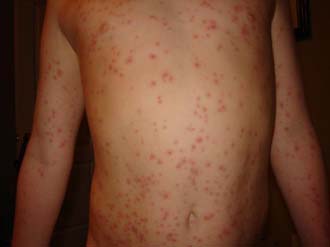
The travelers blamed the resort owner for their plight. Assuming for a moment that the travelers are correct that the hot tub was the source of the infection, what measures might the resort have taken to prevent this unfortunate outcome?
Chapter 2 - Summary Questions
1. A conditioning film is a prerequisite for the formation of a biofilm, but not a stage in biofilm development. Explain this statement.
2. Which of the following strategies would you consider to have the best chance of preventing or eliminating biofilm infections in patients who have received an artificial implant such as this prosthetic hip (below)
Explain your answer(s).
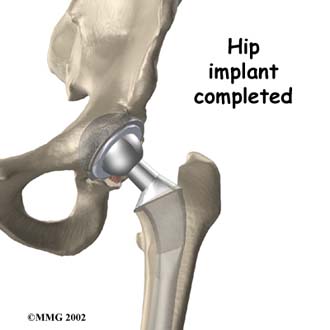
- A. Heavy metal disinfectant treatment of the implant prior to surgery.
B. New antibiotics
C. Quorum sensing inhibitors that prevent attachment.
D. Compounds that encourage premature detachment of the biofilm.
3. Distinguish between these hypotheses each of which attempts to explain the increased resistance of biofilm cells to antibiotics.
-
A. Metabolic quiescence hypothesis
B. Persister cell hypothesis
4a. Describe four advantages that bacterial cells in biofilms may have over
planktonic cells.
4b. Describe any advantages you feel planktonic cells may have over biofilm
cells?
5. Consider the case described in the text in which asthmatics were infected with Pseudomonas aeruginosa as a result of using contaminated albuterol inhalers. What precautions might the pharmaceutical company have employed that would have prevented this tragic incident?
6. The concept of Emergence as in the emergent properties of complex systems is fascinating. Aside from biofilms, can you think of any other biological systems, which in your opinion exhibit emergent properties?
Chapter 2 - Scenerio Questions
1. A 12-year-old patient has just had the mitral valve in his heart due to a severe congenital anomaly. This valve is the one between the left atrium and left ventricle of the heart. In about 4 % of cases, such surgery is followed by infection of the valve and destruction of heart tissue leading to, as the doctors say, an unfortunate outcome.|
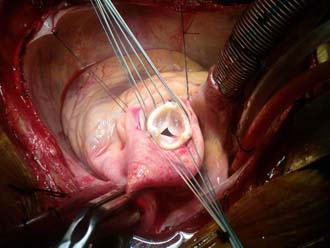
-
A. What precautions should this patient and his family take to reduce the chances of heart valve infection?
B. What professionals this child comes into contact with should be aware of his surgery? Why in each case?
C. Consider for a moment T. Smith’s expression, P=NV/R. How does each variable in this expression affect the probability that this child may develop a postoperative infection?
2. In marine and freshwater, chitin, found in the exoskeletons of freshwater and marine shellfish e.g. crabs lobsters, shrimp, and crayfish is a very common substratum for the growth of bacteria.
In some instances one finds that the bacteria growing in pure culture and forming a biofilm on the chitin are not all producing chitinase, the enzyme that degrades chitin to simple sugars.
Researchers have found that nearly 100 percent of the bacteria which disperse from these biofilms, come from the subpopulation that is not synthesizing chitinase although they are capable of doing so genetically.
It would appear that there is a division of labor in this biofilm. Some cells “giving up” their ability to reproduce (chitinase producers) and others which will form the migratory pioneers (non-producers).
Do you feel that this qualifies as an example of “altruism” among the bacteria.
How is this different that the sacrifice parents make to send their children off to college at great expense in hopes of ensuring their future success?
3. Pharmaceutical and health related industries have spent millions of dollars attempting to find materials to which bacterial cells will not attach. Many such materials have been proposed by the research laboratories of these companies. Invariably, however, when tested by laboratories specializing in biofilm research, these materials fail the test of limiting biofilm growth. What do you think the biofilm laboratories know that the industrial laboratories are overlooking?
4. The text refers to organisms with various types of reproductive strategies named r and K.
a. List 3 advantages and disadvantages of each reproductive strategy.
b. Name one organism, not mentioned in the Hypertextbook that you feel fits the description of an r and a K selected organism.
c. Consider a bacterium growing in a fast flowing stream (lotic environment). How might such an organisms benefit by being able to shift back and forth between the biofilm and planktonic phenotypes?
5. What is the evidence that Quorum Sensing molecules exist in nature (i.e. that Acyl –homoserine lactones are not strictly a laboratory phenomenon)?
6. The following image is from an article by Davies et al. and shows X-Z images of a wild type Pseudomonas biofilm, a biofilm of the same organisms bearing a lasI mutation and the las I mutant with added Homoserine lactone . Note how flat the mutant is compared to the wild type mushroom-shaped biofilm. What does the third panel suggest about the deficiency in the lasI matant?
